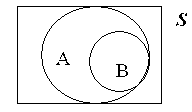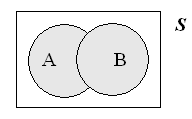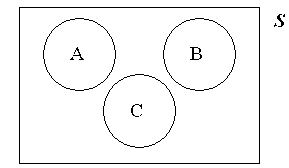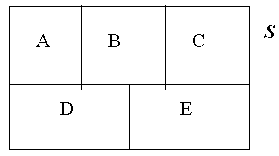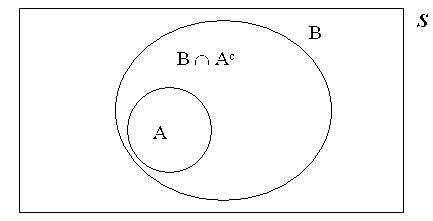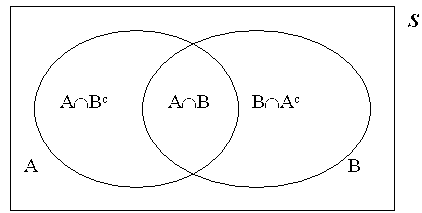LEGACY CONTENT.
If you are looking for Voteview.com, PLEASE CLICK HEREThis site is an archived version of Voteview.com archived from University of Georgia on
May 23, 2017. This point-in-time capture includes all files publicly linked on Voteview.com at that time. We provide access to this content as a service to ensure that past users of Voteview.com have access to historical files. This content will remain online until at least
January 1st, 2018. UCLA provides no warranty or guarantee of access to these files.
The basic idea of counting methods is simply to form the ratio of the
number of elements in the Event, E, to the number of elements in the
Sample Space, S. The ratio is the probability of E. That is:
P(E) = (number of elements in E)/(number of elements in S)
Simple examples of counting problems are in (6) above.
Problem: We roll 6 dice. What is the probability that each number
appears exactly once? Answer: Clearly S contains 66 elements. The
Event "Each number appears exactly once" has 6! elements.
To see this, think about rolling one die at a time. You do not
care which number comes up first. Now remove that number from the second die so
it is five-sided and roll it: 6x5. Etc. (Note that when you are counting
the number of elements in an event you are not doing probability!) Hence:
P(E) = 6!/66
People and Chairs. The number of
permutations of n elements taken k at a time. The classic example is the
number of ways that n people can be placed in k chairs (n ³k).
The answer is:
n(n-1)(n-2)...(n-k+1) = n!/(n-k)! = Pkn
This is easy to see by doing the thought experiment of randomly assigning one
person at a time to the chairs.
Boxes and Balls. Suppose we have 20
boxes and 15 balls. We toss the balls randomly into the boxes. What is the
probability that when we are finished that no box contains more than one ball?
Clearly the sample space has 2015 elements. To count the number of outcomes
in the Event "no box contains more than one ball" do the following thought
experiment. Imagine tossing the balls into the boxes one at a time. After you
toss the first ball go and remove the box that it lands in. This leaves 19
boxes. Now toss the second ball and then remove the box that it lands in. Etc.
Hence: 20x19x18... = 20!/5!
Answer: (20!/5!)/2015
The Birthday Problem. What is the probability that in a group of n
people that at least two people have the same birthday? (Caveats: just day and
month; no twins; ignore Feb. 29). To get the answer, use the rule of the
complement and find the probability that everyone has a different birthday. (This
is like having 365 boxes and n balls!). Namely,
Let E = {At Least Two People Have the Same Birthday}. Hence
P(E) = 1 - P(Everyone has a Different Birthday). Using the Boxes and Balls
Logic:
P(Everyone has a Different Birthday) = (365!/(365-n)!)/365n
By the Rule of the Complement the answer is: 1 - (365!/(365-n)!)/365n
With n = 23, P(E) = .507; when n= 30, P(E) = .706; and
when n = 60, P(E) = .994.
Combinations (Binomial Coefficients). The
classic example of a binomial coefficient is committee formation; viz.,
suppose we have n people and we want a committee of k people
(n ³ k).
How many different ways can we form the committee? Answer:
ænö
ç ÷
èkø
Note that:
ænö æ n ö ænö ænö
ç ÷ = ç ÷ and ç ÷ = ç ÷ = 1
èkø èn-kø ènø è0ø
Example. Suppose a judge has 50 people from which to randomly choose
a jury of 12 people. How many different juries could she form? Answer:
æ50ö 50!
ç ÷ = ------
è12ø 12!38!
Note that we do not care in what order the jurors sit in the jury box!
We are only interested in the collection of 12 people. This is why
the division by 12! is in the formula. If this were a simple
people in chairs problem, the answer would be 50!/38!. To get the unique
number of collections of 12 people we divide the 50!/38! by 12!
because the 50!/38! includes all the permutations of each collection
of 12 people.
Example. Suppose we have 30 people -- 20 women and 10 men. We have
to randomly select 8 people to form a committee. What is the probability
that we get exactly 4 women and exactly 4 men on the committee?
The event here is "4 women and 4 men". To get the probability of the
event, we need to form the ratio of the number of elements in E to
the number of elements in the sample space, S. Clearly, the number
of elements in S is: [30 choose 8]. To get the number of elements
in E think of the men and women as being in separate groups. If we
randomly pick 4 women from the 20 women, [20 choose 4], and multiply it by
the number of ways we could randomly pick 4 men from the 10 men, [10 choose 4],
this is the number of elements in E. Hence:
æ20öæ10ö
ç ÷ç ÷
è 4øè 4ø
P(E) = ---------
æ30ö
ç ÷
è 8ø
With reference to (6), what is the probability that our committee of 8
people will have at least 4 women?
This is a simple extension of (6). Note that this is the sum:
P[4 women, 4 men] + P[5 women, 3 men] + P[6 women, 2 men] + etc.
So the answer is:
æ20öæ 10 ö
ç ÷ç ÷
8 è jøè 8-jø
P(E) = å ---------
j=4 æ30ö
ç ÷
è 8ø
Problem 2.33a-d MWS p. 44.
This is the same form as (5) only now our two groups are 4 organizers and
46 non-organizers from which we pick 3 winners (a committee of size 3). The
Sample Space is: S = [50 choose 3] and the event for part (a) is
E= {the 3 winners are also organizers}.
Answer for (a):
æ4öæ46ö
ç ÷ç ÷
è3øè 0ø
P(E) = ---------
æ50ö
ç ÷
è 3ø
The answers for (b), (c), and (d) all have the same form as (a).
6 Dice Problem ((23) in notes #1)
Think of the 6 dice in an urn. To count the number of elements in the event,
"each number appears exactly once", randomly pick one die and make it
the number one. This can be done [6 choose 1] ways since any one of the dice
could be the number one. Now randomly pick one die from the 5 remaining to
be the number two. This can be done [5 choose 1] ways. Etc. Answer:
æ6öæ5öæ4öæ3öæ2öæ1ö
ç ÷ç ÷ç ÷ç ÷ç ÷ç ÷
è1øè1øè1øè1øè1øè1ø
P(E) = --------------
66
Playing Card Problems. A standard deck of
52 playing cards consists of two kinds of objects: Denominations,
2, 3, 4, 5, 6, 7, 8, 9, 10, J, Q, K, A (in that order); and Suits,
Spades (ª),
Hearts (©),
Diamonds (¨),
Clubs (§). There are 13 denominations with 4 cards
in each denomination; and there are 4 suits with 13 cards in each suit.
First Problem. Suppose we randomly select 4 cards. What is the probability
that we get exactly one card in every suit? For Example:




This is just an elaboration of the men-women committee problem in (5). Only
now we have four groups, not two. Clearly our sample space has [52 choose 4]
elements. To get the probability we have to count the number of elements in
the event "exactly one card in every suit".
The technique here is the same used above. Think of the 52 cards separated
into the four suits (just as we separated the men and women). Now pick one
card from each group of 13 cards. This is the number of elements in E.
Answer:
æ13öæ13öæ13öæ13ö
ç ÷ç ÷ç ÷ç ÷
è 1øè 1øè 1øè 1ø
P(E) = --------------
æ52ö
ç ÷
è 4ø
Suppose we randomly select 5 cards. What is the probability that we
get 2 cards from one denomination and 3 cards from a second denomination? For
example:





Clearly the sample space has [52 choose 5] elements. To get the probability
we have to count the number of elements in the event "2 cards from one denomination
and 3 cards from a second denomination".
The technique here is more complicated than the previous problems. Here
we have 13 denominations from which we choose 2. This is the number of pairs
of denominations: A,K; 2,3; 4,J; A,8; 2,3; etc. However, note that
for every pair of denominations, e.g., Aces and Kings, there are two ways you
can get the event; viz., AAAKK and AAKKK respectively. Consequently, you have to take
that into account: [2 choose 1]. Now you have one denomination designated as the
one that will be the 3 cards, and one denomination designated as the one that
will be the 2 cards. Now you draw 3 from the first and 2 from the second thereby
counting all the possible elements in the event.
Answer:
æ13öæ2öæ4öæ4ö
ç ÷ç ÷ç ÷ç ÷
è 2øè1øè3øè2ø
P(E) = --------------
æ52ö
ç ÷
è 5ø
Suppose we randomly select 5 cards. What is the probability that we
get 2 cards from one denomination and 1 card each from three other denominations.
For example:





Clearly the sample space has [52 choose 5] elements. To get the probability
we have to count the number of elements in the event "2 cards from one denomination
and 1 card each from three other denominations".
The technique here is similar to (11). To count the number of elements in E
we first select 4 denominations, then we select one of the 4 denominations to be
the one from which we draw 2 cards, then we draw the cards from each denomination.
Answer:
æ13öæ4öæ4öæ4öæ4öæ4ö
ç ÷ç ÷ç ÷ç ÷ç ÷ç ÷
è 4øè1øè2øè1øè1øè1ø
P(E) = ---------------
æ52ö
ç ÷
è 5ø
Suppose we randomly select 5 cards. What is the probability that we
get a sequence in one suit. For example,





(By definition, the order of the denominations is:
2, 3, 4, 5, 6, 7, 8, 9, 10, J, Q, K, A.)
Clearly the sample space has [52 choose 5] elements. To get the probability
we have to count the number of elements in the event "sequence in one suit".
This is a disguised version of the men-women problem (5). Here the two groups
are the 4 suits and the 9 possible sequences: 23456; 34567; 45678; etc. To count
the number of elements in the event we simply draw one suit and draw one sequence.
Answer:
æ4öæ9ö
ç ÷ç ÷
è1øè1ø
P(E) = ---------
æ52ö
ç ÷
è 5ø
Suppose we randomly select 5 cards. What is the probability that we
get a sequence.
This is the same as (13) only we do not care about the suits of the cards. As in
(13), to count the number of elements in the event "sequence" we have to pick
one of the 9 possible sequences but in doing so we are selecting 5 denominations
in sequence. Consequently, after we pick the sequence we draw one card from
each of the corresponding denominations. Answer:
æ9öæ4ö5
ç ÷ç ÷
è1øè1ø
P(E) = ---------
æ52ö
ç ÷
è 5ø
Multinomial Coefficients. A Multinominal
coefficient is simply the product of binomial coefficients. In can be thought
of as multiple committee formation.
For example, suppose we have 40 people and we want to randomly divide
them into committees of sizes 15, 15, and 10. How many ways can we do this?
A common sense answer is first to randomly choose committee number one --
[40 choose 15] -- then committee number two -- [25 choose 15] -- and the
remaining 10 people are the third committee: that is;
æ40öæ25öæ10ö 40! 25! 10! 40!
ç ÷ç ÷ç ÷ = ------- * ------- * ------ = ----------
è15øè15øè10ø 15!25! 15!10! 10!0! 15!15!10!
Note that this is the same as:
æ40öæ30öæ15ö 40! 30! 15! 40!
ç ÷ç ÷ç ÷ = ------- * ------- * ------ = ----------
è10øè15øè15ø 10!30! 15!15! 15!0! 10!15!15!
and we write it as:
æ 40 ö
ç ÷
è15 15 10ø
The general form of this is:
æ n ö æ n öæn-n1öæn-n1-n2 ö
ç ÷ = ç ÷ç ÷ç ÷ ...
èn1 n2 n3 ... nk ø è n1 øè n2 øè n3 ø
which is equal to:
n!
----------------
n1!n2!n3! ... nk!
Suppose, as in (15), we have 40 people -- 25 men and 15 women -- and
we are forming committees of size 15, 15, and 10 respectively. What is the
probability that we get exactly 5 women on each committee?
This is just an elaboration of (5). Clearly the number of elements in our
sample space is the multinomial coefficient given in (15): [40 choose 15,15,10]
To count the number of elements in the event "exactly 5 women on each committee"
we can use exactly the same technique as we used in (5) but now we do it for
all three committees.
The number of ways the first committee could be formed is:
[15 choose 5][25 choose 10].
For the second committee:
[10 choose 5][15 choose 10].
The remaining 5 women and 5 men are the third committee.
Hence the answer is:
æ15öæ25öæ10öæ15öæ5öæ5ö
ç ÷ç ÷ç ÷ç ÷ç ÷ç ÷
è 5øè10øè 5øè10øè5øè5ø
P(E) = --------------------
æ 40 ö
ç ÷
è15 15 10ø
Note that we can get the same answer by randomly dividing the 15 women up
into three groups of 5 each, corresponding to the three committees;
and randomly dividing the 25 men up into groups
of 10, 10, and 5, corresponding to the three committees. This product of two
multinomial coefficients is the number of elements in the event. Hence
the answer is:
æ 15 öæ 25 ö
ç ÷ç ÷
è5 5 5øè10 10 5ø
P(E) = ---------------
æ 40 ö
ç ÷
è15 15 10ø
Example 2.10, p. 39-40:
The book's answer for this problem is:
æ 16 ö
ç ÷
è2 4 5 5ø
P(E) = ---------
æ 20 ö
ç ÷
è6 4 5 5ø
However, we could have used the same reasoning as in (17). Namely,
there are two kinds of laborers -- 4 from the ethnic group, and 16 others.
To form the first job (a "committee" of size 6), we need all 4 members of
the ethnic group and 2 from the others. Hence, there are:
[4 choose 4][16 choose 2] ways the first job requiring 6 laborers could have
been randomly filled. Continuing with the same reasoning, for the second job
there are
[4 choose 0][14 choose 4] ways of choosing the laborers. Etc. Hence:
æ 16 ö æ4öæ16öæ4öæ14öæ4öæ10öæ4öæ5ö æ16öæ14öæ10öæ5ö
ç ÷ = ç ÷ç ÷ç ÷ç ÷ç ÷ç ÷ç ÷ç ÷ = ç ÷ç ÷ç ÷ç ÷
è2 4 5 5ø è4øè 2øè0øè 4øè0øè 5øè0øè5ø è 2øè 4øè 5øè5ø
Similarly:
æ 20 ö æ20öæ14öæ10öæ5ö
ç ÷ = ç ÷ç ÷ç ÷ç ÷
è6 4 5 5ø è 6øè 4øè 5øè5ø
Hence the following is equivalent to the book's answer:
æ16öæ14öæ10öæ5ö
ç ÷ç ÷ç ÷ç ÷
è 2øè 4øè 5øè5ø
P(E) = --------------
æ 20 ö
ç ÷
è6 4 5 5ø
Example 2.10, p. 39-40 (Cont.):
Recall that the book's answer for this problem is:
æ 16 ö
ç ÷
è2 4 5 5ø
P(E) = ---------
æ 20 ö
ç ÷
è6 4 5 5ø
Another way to think about this problem is to first divide the 4 laborers from
the specific ethnic group into the 4 jobs and multiply that by the the number
of ways that the 16 other labors can be divided into the 4 jobs. Clearly, there
are:
æ 4 ö
ç ÷
è4 0 0 0ø
ways that the 4 labors can all be placed in the bad job. Hence:
æ 4 öæ 16 ö
ç ÷ç ÷
è4 0 0 0øè2 4 5 5ø
P(E) = -----------------
æ 20 ö
ç ÷
è6 4 5 5ø
